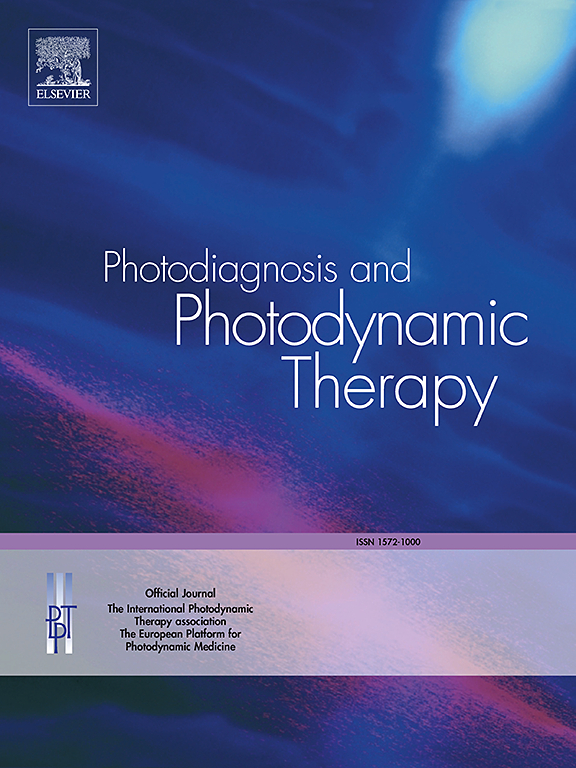术中应用吲哚菁绿激光血管造影测量喉癌手术治疗中皮肤灌注的可行性研究。
IF 3.1
3区 医学
Q2 ONCOLOGY
引用次数: 0
摘要
背景:全喉切除术(TL)是治疗喉癌的主要或挽救性治疗方案之一。抢救性TL (STL)术后,由于组织灌注不良和缺氧,伤口愈合延迟是常见的。本研究旨在评估术中使用吲哚菁绿(ICG)荧光激光血管造影测量皮肤灌注对接受喉癌全喉切除术和/或喉癌颈部清扫的患者是否可行。方法:包括因喉癌而接受原发性TL、STL和/或颈部清扫的患者。术中使用Quest Spectrum®2相机进行ICG荧光测量。术前和术后分别对皮肤切口下方和上方进行28个点和4个场的皮肤灌注测量。测量峰值荧光(Fmax)和进入率(IR),比较平均灌注水平,并使用非参数统计检验估计方差。评估灌注水平与既往放疗及术后伤口并发症的相关性。结果:6例患者中,每例进行32次测量(共192次)。结论:使用ICG的激光血管造影可以可靠地进行皮肤灌注测量,但由于无法确定一致的模式或参考灌注水平,因此在临床研究中不适用。本文章由计算机程序翻译,如有差异,请以英文原文为准。
Intra-operative laser angiography measurement of skin perfusion using indocyanine green dye in surgical treatment of laryngeal cancer: A feasibility study
Background
Total laryngectomy (TL) is one of the primary or salvage treatment options for the treatment of laryngeal cancer. After salvage TL (STL), delayed wound healing, due to poor tissue perfusion and hypoxia is frequent. This study aimed to assess whether measurement of skin perfusion using intra-operative indocyanine green (ICG) fluorescence laser angiography is feasible in patients undergoing total laryngectomy and/or neck dissection for laryngeal cancer.
Methods
Patients who underwent primary TL, STL and/or neck dissection for laryngeal cancer were included. ICG fluorescence measurements were performed intra-operatively using the Quest Spectrum® 2 Camera. A total of 28 point and 4 field measurements were performed of skin perfusion pre- and post-operatively below and above the skin incision. Peak fluorescence (Fmax) and ingress rate (IR) were measured for comparing mean perfusion levels and estimating variance using non-parametric statistical tests. Correlation of perfusion levels with previous radiotherapy and postoperative wound complications was assessed.
Results
In each of the six included patients, 32 measurements were performed (total: 192). Point and field method outcomes were strongly correlated (p < 0.001). Mean Fmax was 121.1 (I) (± 41.34 SD) for point and 123.9 (I) (± 42.9 SD) for field measurements. Mean IR was 10.4 (I/s) (± 2.75 SD) for point and 9.9 (I/s) (± 3.03 SD) for field measurements. Point measurements showed high intra-patient variation. Inter-patient variation of skin perfusion was also high both for cranial and caudal flap and for pre- and post-operative measurements. No clinically relevant associations between perfusion levels and radiotherapy or wound complications were found.
Conclusion
Laser angiography using ICG can reliably perform skin perfusion measurements, yet it is not clinically applicable to the clinical situation studied, since no consistent patterns or reference perfusion levels can be identified.
求助全文
通过发布文献求助,成功后即可免费获取论文全文。
去求助
来源期刊

Photodiagnosis and Photodynamic Therapy
ONCOLOGY-
CiteScore
5.80
自引率
24.20%
发文量
509
审稿时长
50 days
期刊介绍:
Photodiagnosis and Photodynamic Therapy is an international journal for the dissemination of scientific knowledge and clinical developments of Photodiagnosis and Photodynamic Therapy in all medical specialties. The journal publishes original articles, review articles, case presentations, "how-to-do-it" articles, Letters to the Editor, short communications and relevant images with short descriptions. All submitted material is subject to a strict peer-review process.
 求助内容:
求助内容: 应助结果提醒方式:
应助结果提醒方式:


